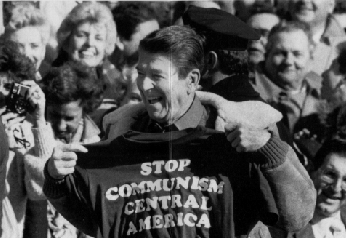Crimes against Humanity in Guatemala: How the CIA and the Pentagon Supported the Military Dictatorship
 |
| "I was only following orders from my superiors"... Ronald Reagan |
Masks of Investment: a Trial in Guatemala
by J. B. Gerald
They seemed more than any other people to love their children"
- Bartolomé de las Casas
In Guatemala the trial of Gen. Efraín Ríos Montt and his military intelligence chief, José Mauricio Rodríguez Sánchez, proceeds with testimonies of surviving Mayan victims1 ; a soldier has given testimony implicating the current President of Guatemala, Otto Pérez Molina, a major at the time, in crimes of the Ixil area under his responsibility.2 The trial can be followed online at http://www.riosmontt-trial.org/.
In rural Iowa, the Muscatine Journal3 finds the degree of the crime horrifying, noting the U.S. military contributed 90% of the Guatemalan army's resources. The New York Times op. ed page,4 notes that the terrible details of what was done to Mayan victims aren't likely to dignify them. As the horror under Ríos Montt's rule is revealed in the States, any link to the military regime's motive is ignored. The reason for the campaign of exterminating Mayan Indians appears to be military: native communities were accused of providing shelter for a guerrilla movement.
The United Fruit Company overthrow of elected President Arbenz, referred to as a CIA takeover, secured growing-land. The United Fruit Company's motive was purely profit, which increases with an absence of local resistance, and increases again when there isn't appropriate compensation to the peoples whose lands are used for foreign profits.
Throughout the Caribbean the barbarities of the New World's discovery were initially fueled by the greed for gold: in the early 1500's the genocide of the Arawak people was firmly established; they were forced to mine gold under such intolerable conditions that great numbers committed suicide. Other groups had resisted naked with wooden swords: the mayhem which wearied Spanish soldiers by the end of each day, cleared land for plantation use.
Guatemala's former dictator Ríos Montt and General Sánchez are now on trial, five hundred years later, for genocide of Ixil Mayan Indians from 1982 to 1983. The trial is the first to question in a court of the Americas, Christianity's and Europe's history on this side of the ocean. After immunity as a Guatemalan Senator, a very old general who has outlasted his firmly diabolical strength is finally called to account for the ongoing crime so deep in North, Central and South America that we can't see ourselves reflected in its mirror.
 |
| Guatemalans set up a “disappeared wall” during one of the protests to demand the trial of Ríos Montt. |
Ríos Montt supporters have demonstrated outside the trial insisting "There was no genocide," while within the courthouse the judge must consider deaths of possibly 300,000 Mayan Indians, overwhelming evidence from previous international deliberations and current devastating testimonies. Disturbingly the protest is accompanied by the March 17th kidnapping of four Indigenous leaders and execution of one of them. The Xinca people are opposing Escobal silver mine, owned by Canada's Goldcorp and Tahoe Resources. The company is attempting to extract resources, against the wishes of the majority of the area's Indian population.
And days before a High Court decision allowed the genocide trial to proceed6 , on March 15th, Guatemala's highest court sided with the mining corporations against indigenous people by affirming the Mining Law of 1997 which denies indigenous people their voice in the use and disposition of their lands. Mining Watch Canada points out the ruling contravenes not only the Guatemalan Peace Accords, the American Convention on Human Rights, the International Labour Organization Convention No. 169 "on the rights of indigenous and tribal peoples," but also the United Nations Declaration on the Rights of Indigenous Peoples. The case will now go to the Inter-American Commission on Human Rights.7
While Guatemala's trial of Ríos Montt on charges of genocide provides North Americans with an introduction to awareness, the same dynamic to control land and resources is reflected in Argentina, Chile, Brazil, Peru, Honduras, Haiti, among other countries of the Americas. Its parallels in the U.S. and Canada are masked in long established economic controls.
In Argentina, seven military and security personnel were recently convicted of "crimes against humanity within the context of genocide."8 The country's former dictator, General Jorge Rafael Videla, is on trial for the war crimes during his participation in "Operation Condor." Already sentenced to life in prison for other war crimes, on March 17th he publicly threatened the current government with a military led uprising.9 Videla represents a rule by terror which proved acceptable to the middle classes and was essentially coordinated by and at the service of U.S. and global corporate interests. Information on the current trial is becoming increasingly difficult to find and is currently entirely suppressed by the news media.
The issue dropped from coverage shortly after selection of Pope Francis (of Argentina). Claims of the new Pope's collaboration with the Videla government's crimes are contested by the Church. Evidence from the indictment and trial of Videla and his intelligence chief for their responsibilities under Operation Condor, may encourage trials in Chile, Paraguay, Uruguay, among countries involved in a military program which exterminated dissidents and leftists throughout South and Central America... Read more>>j.b.gerald
Related:
